
Electoral College Explained: A Key Element of U.S. Presidential Elections
In the United States, the method of selecting a president is through the Electoral College system, which in 2016 saw Donald Trump triumph, just as it did for George W. Bush in 2000. This unique mechanism differs from a straightforward popular vote and profoundly influences election strategies and outcomes. Both Trump and Bush secured the presidency without achieving the majority of the nationwide popular vote, leaning instead on their advantages within the Electoral College.
Critics, particularly from the Democratic party, argue that this system disproportionately favors Republican candidates. They advocate for a simplification of the process, suggesting that a straightforward majority vote should determine the winner. However, changing this system would necessitate a constitutional amendment, as it was originally devised by the nation’s framers.
What is the Electoral College?
The Electoral College comprises 538 electors, established by the framers of the Constitution to empower state governments and prevent Congress from unilaterally deciding presidential elections. Each state allocates its electors based on its Congressional representation. The candidate who earns the most votes in a state typically receives all of that state’s electoral votes, with the exceptions being Nebraska and Maine, where votes can be distributed by congressional district as well as statewide.
A presidential candidate must acquire 270 electoral votes—considered a majority of the total available votes—to secure victory.
Disparities Between Electoral and Popular Votes
The Electoral College inherently assigns more significance to votes from smaller states, resulting in scenarios where the national popular vote does not align with the Electoral outcome. Consequently, the strategies candidates employ during campaigning shift, leading them to focus on battleground states that exhibit a history of splitting their votes rather than heavily Democratic or Republican strongholds.
Allocation of Electoral Votes by State
Electoral votes are distributed based on the number of a state’s representatives in the House, in addition to its two senators. Notably, the District of Columbia receives three electoral votes, despite lacking Congressional representation. California tops the list with 54 electoral votes, followed by Texas with 40, and Florida with 30. In the context of competitive states, Pennsylvania claims 19 electoral votes, with Georgia and North Carolina both holding 16.
Who Are the Electors?
The selection of electors varies by state, with many being appointed by political parties. Importantly, members of Congress cannot serve as electors.
Processes of Voting and Certification
Post-certification by state election officials, electors convene in their respective states—not as a collective body—on December 17 to certify the election results. In the event of an electoral tie, the decision moves to the House of Representatives, where each state’s delegation casts one vote—a scenario that has only occurred twice in American history, in 1801 and 1825.
Following the certification, electors send their results to Congress, which conducts an official count of the electoral votes during a special session on January 6. The vice president oversees the process, which involves opening and verifying official envelopes from each state.
Can Lawmakers Contest Election Results?
During Congressional certification, lawmakers have the ability to raise objections to a state’s results. This was notably exercised by several Republicans following the 2020 election; however, Congress ultimately voted against these objections concerning results in Arizona and Pennsylvania on January 6, 2021.
In the aftermath of the Capitol insurrection, Congress revised the Electoral Count Act originally instituted in the 1800s to mitigate possibilities for objections and delineate the vice president’s ceremonial responsibilities. This was particularly relevant after former President Trump’s attempts to reverse the electoral outcome by pressuring Vice President Mike Pence, who lacked the legal authority to do so.
Once Congress finalizes the count of electoral votes, the president-elect or re-elected president will be sworn in on January 20, on the steps of the Capitol.
